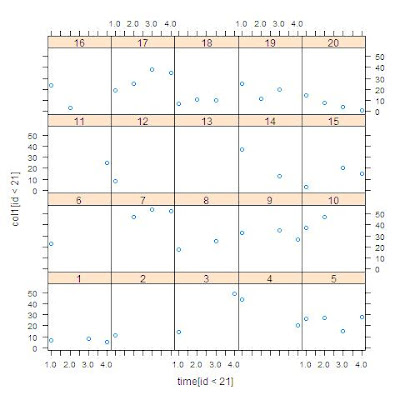Suppose we wanted to plot CESD over time for each individual. While we show how to do this sort of thing in SAS (see section 5.6.2), it’s hard to do without SAS version 9.2. Instead, we recall it’s easy using the lattice library in R (see section 5.2.2). But we need a ”long” data set with a row for each time point. This is the sort of data management one might prefer to do in SAS.
SAS
First, we read the data from a data set stored in SAS format. Then we use proc transpose (section 1.5.3) to get the data into the required shape. Finally, we save the ”long” data set in Stata format (1.2.2).
libname k "c:\book";
proc transpose data=k.help out=ds1;
by id;
var cesd1 cesd2 cesd3 cesd4;
run;
proc print data = ds1 (obs = 5); run;
Obs ID _NAME_ _LABEL_ COL1
1 1 CESD1 1 cesd 7
2 1 CESD2 2 cesd .
3 1 CESD3 3 cesd 8
4 1 CESD4 4 cesd 5
5 2 CESD1 1 cesd 11
proc export data=ds1 (rename=(_label_=timec1))
outfile = "c:\book\helpfromsas.dta" dbms=dta;
run;
R
In R, we first read the file from Stata format (1.1.5), then attach() it (section 1.3.1) for ease of typing. Then we check the first few lines of data using the head() function (section 1.13.1). Noting that the time variable we brought from SAS is a character string, we convert it to a numeric variable using as.numeric() (section 1.4.2) and substr() (section 1.4.3). After loading the lattice library, we display the series for each subject. In this, we use the syntax for subsetting observations (1.5.1) to keep only the first 20 observations and the as.factor() function (1.4.10) to improve the labels in the output.
> library(foreign)
> xsas <- read.dta("C:\\book\\helpfromsas.dta")
> head(xsas)
id _name_ timec1 col1
1 1 CESD1 1 cesd 7
2 1 CESD2 2 cesd NA
3 1 CESD3 3 cesd 8
4 1 CESD4 4 cesd 5
5 2 CESD1 1 cesd 11
6 2 CESD2 2 cesd NA
> attach(xsas)
> time <- as.numeric(substr(timec1, 1, 1))
> library(lattice)
> xyplot(col1[id < 21] ~ time[id < 21]|as.factor(id[id < 21]))

In the next entry, we'll reverse this process to manipulate data in R and produce the plot in SAS.
5 comments:
I believe there might be an easier way if you use library(sas7bdat.parso) and fread(). Have you considered this?
I haven't tried that one. My go-to library for reading SAS data sets into R these days is haven, which was written by Hadley Wickham.
You should also try the haven library in R, it reads sas7bdat files directly and is works very well.
Randy Sherrod
I agree, Haven is better. Doesn't work on compressed SAS files though.
Haven does handle compressed files now.
Post a Comment